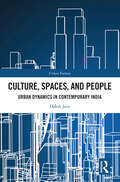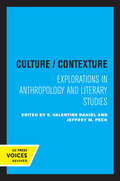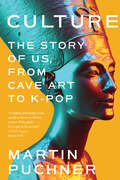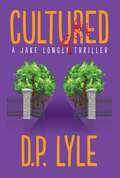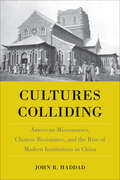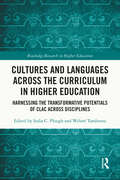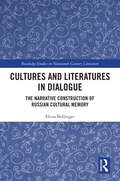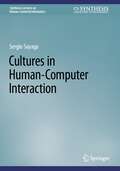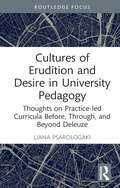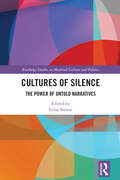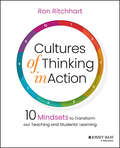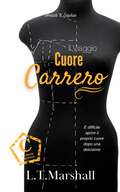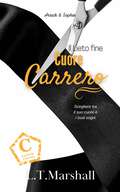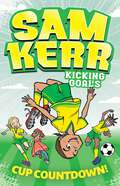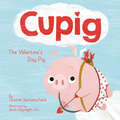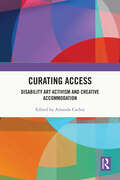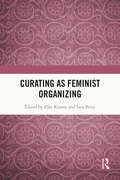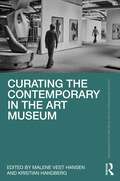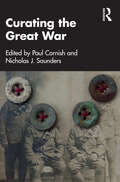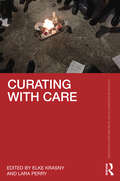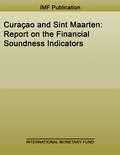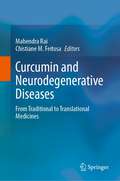- Table View
- List View
Culture, Spaces, and People: Urban Dynamics in Contemporary India (Urban Futures)
by Daksh JainThis volume discusses the nuances of cultural phenomena in the transforming urban landscape of Indian cities. It focuses on the role of globalization, transitioning economic patterns, National Urban policies in changing their urban landscape. The volume argues how culture is an important determinant of the emergent urban patterns. It decodes and determines the human centered inter-linkages such as social, cultural, economic, and political and their reactions in the transformations in urban morphology to understand the spatial perspective and visualization of new emerging cultural phenomena. The book reflects on the contemporary global forces and currently operational national urban policies that have enforced new dynamics of consumption, lifestyles, and institutions. Further, it also examines the ways in which these forces come together to create new hybrid cultures which manifest in spatial practices. With detailed case studies of different cities, this book will be of interest to students, teachers, and researchers of urban planning, cultural studies, urban sociology, urban geography, history, urban design, urban conservation, and policy studies. It will also be useful for professionals working in the field of smart cities in India and abroad, planning authorities, urban scientists, cultural tourists, artists, local cultural enthusiasts, and those interested in studying the urban conditions of Indian cities.
Culture/Contexture: Explorations in Anthropology and Literary Studies
by E. Valentine Daniel Jeffrey M. PeckThe rapprochement of anthropology and literary studies, begun nearly fifteen years ago by such pioneering scholars as Clifford Geertz, Edward Said, and James Clifford, has led not only to the creation of the new scholarly domain of cultural studies but to the deepening and widening of both original fields. Literary critics have learned to "anthropologize" their studies—to ask questions about the construction of meanings under historical conditions and reflect on cultural "situatedness." Anthropologists have discovered narratives other than the master narratives of disciplinary social science that need to be drawn on to compose ethnographies.Culture/Contexture brings together for the first time literature and anthropology scholars to reflect on the antidisciplinary urge that has made the creative borrowing between their two fields both possible and necessary. Critically expanding on such pathbreaking works as James Clifford and George Marcus's Writing Culture and Marcus and Michael M. J. Fischer's Anthropology as Cultural Critique, contributors explore the fascination that draws the disciplines together and the fears that keep them apart. Their topics demonstrate the rich intersection of anthropology and literary studies, ranging from reading and race to writing and representation, incest and violence, and travel and time. This title is part of UC Press's Voices Revived program, which commemorates University of California Press’s mission to seek out and cultivate the brightest minds and give them voice, reach, and impact. Drawing on a backlist dating to 1893, Voices Revived makes high-quality, peer-reviewed scholarship accessible once again using print-on-demand technology. This title was originally published in 1996.
Culture: The Story Of Us, From Cave Art To K-pop (The\oxford Research Centre In The Humanities/princeton University Press Lectures In European Culture Ser. #1)
by Martin PuchnerNew York Times Editors’ Choice “A mighty, polymathic work, equally at home in all four corners of the globe.… It is a gift to be savored.” —Chris Vognar, Boston Globe In Culture, acclaimed author, professor, and public intellectual Martin Puchner takes us on a breakneck tour through pivotal moments in world history, providing a global introduction to the arts and humanities in one engaging volume. What good are the arts? Why should we care about the past? For millennia, humanity has sought to understand and transmit to future generations not just the “know-how” of life, but the “know-why”—the meaning and purpose of our existence, as expressed in art, architecture, religion, and philosophy. This crucial passing down of knowledge has required the radical integration of insights from the past and from other cultures. In Culture, acclaimed author, professor, and public intellectual Martin Puchner takes us on a breakneck tour through pivotal moments in world history, providing a global introduction to the arts and humanities in one engaging volume. From Nefertiti’s lost city to the plays of Wole Soyinka; from the theaters of ancient Greece to Chinese travel journals to Arab and Aztec libraries; from a South Asian statuette found at Pompeii to a time capsule left behind on the Moon, Puchner tells the gripping story of human achievement through our collective losses and rediscoveries, power plays and heroic journeys, innovations, imitations, and appropriations. More than a work of history, Culture is an archive of humanity’s most monumental junctures and a guidebook for the future of us humans as a creative species. Witty, erudite, and full of wonder, Puchner argues that the humanities are (and always have been) essential to the transmission of knowledge that drives the efforts of human civilization.
Cultured (The Jake Longly Series #6)
by D. P. LyleMoney, sex, power. Jonathon Lindemann offers it all—just don't mind the missing girls. Jake Longly, ex-pro baseball player turned restauranteur, is back where he belongs: relaxing on the beach in front of his restaurant in Gulf Shores, Alabama. His peace is interrupted, however, when he receives a call from his private investigator father—April Wilkerson has gone missing from Lindemann Farms, the rustic, yet posh, resort built by self-help and financial guru Jonathon Lindemann. Lindemann, founder of The Lindemann Method (TLM), recruits wealthy people to join his program, charging a hefty entry fee but in return promising huge financial gains and self-enlightenment. Jake's celebrity status makes him the best person for the case. When Jake and his girlfriend, Nicole, go on an undercover visit to Lindemann Farms, some suspicious activity makes them wonder about the legitimacy of TLM. Soon, a private conversation with one of the girls hired to work at the resort reveals their unorthodox, and immoral, recruitment methods. As the layers peel away, darker edges appear. Does Jonathon truly make money for his investors, or is he a scam artist? Is April merely the latest in a series of missing young women? Jake and Nicole need to find her, and soon, before TLM catches wind of their true reasons for visiting the farm.Perfect for fans of Carl Hiaasen and Janet Evanovich While all of the novels in the Jake Longly Thriller Series stand on their own and can be read in any order, the publication sequence is:Deep SixA-ListSunshine StateRiggedThe OCCultured
Cultures Colliding: American Missionaries, Chinese Resistance, and the Rise of Modern Institutions in China
by John R HaddadAs incredible as it may seem, the American missionaries who journeyed to China in 1860 planning solely to spread the Gospel ultimately reinvented their entire enterprise. By 1900, they were modernizing China with schools, colleges, hospitals, museums, and even YMCA chapters. In Cultures Colliding, John R. Haddad nimbly recounts this transformative institution-building—how and why it happened—and its consequences. When missionaries first traveled to rural towns atop mules, they confronted populations with entrenched systems of belief that embraced Confucius and rejected Christ. Conflict ensued as these Chinese viewed missionaries as unwanted disruptors. So how did this failing movement eventually change minds and win hearts? Many missionaries chose to innovate. They built hospitals and established educational institutions offering science and math. A second wave of missionaries opened YMCA chapters, coached sports, and taught college. Crucially, missionaries also started listening to Chinese citizens, who exerted surprising influence over the preaching, teaching, and caregiving, eventually running some organizations themselves. They embraced new American ideals while remaining thoroughly Chinese. In Cultures Colliding, Haddad recounts the unexpected origins and rapid rise of American institutions in China by telling the stories of the Americans who established these institutions and the Chinese who changed them from within. Today, the impact of this untold history continues to resonate in China.
Cultures Colliding: American Missionaries, Chinese Resistance, and the Rise of Modern Institutions in China
by John R HaddadAs incredible as it may seem, the American missionaries who journeyed to China in 1860 planning solely to spread the Gospel ultimately reinvented their entire enterprise. By 1900, they were modernizing China with schools, colleges, hospitals, museums, and even YMCA chapters. In Cultures Colliding, John R. Haddad nimbly recounts this transformative institution-building—how and why it happened—and its consequences. When missionaries first traveled to rural towns atop mules, they confronted populations with entrenched systems of belief that embraced Confucius and rejected Christ. Conflict ensued as these Chinese viewed missionaries as unwanted disruptors. So how did this failing movement eventually change minds and win hearts? Many missionaries chose to innovate. They built hospitals and established educational institutions offering science and math. A second wave of missionaries opened YMCA chapters, coached sports, and taught college. Crucially, missionaries also started listening to Chinese citizens, who exerted surprising influence over the preaching, teaching, and caregiving, eventually running some organizations themselves. They embraced new American ideals while remaining thoroughly Chinese. In Cultures Colliding, Haddad recounts the unexpected origins and rapid rise of American institutions in China by telling the stories of the Americans who established these institutions and the Chinese who changed them from within. Today, the impact of this untold history continues to resonate in China.
Cultures and Languages Across the Curriculum in Higher Education: Harnessing the Transformative Potentials of CLAC Across Disciplines (Routledge Research in Higher Education)
by India C. Plough Weloré TambouraThis richly interdisciplinary volume explores the goals and benefits of the Cultures and Languages Across the Curriculum (CLAC) programs by drawing together noteworthy insights from educators, administrators, researchers, and students who have been directly involved in the CLAC programs at colleges and universities in the United States. Using autoethnographic methods, the authors analyze their personal experiences of CLAC to highlight best practices in establishing CLAC models and showcase ways to integrate languages and cultures into instruction and research across disciplines and contexts. Particular attention is given to the ways in which CLAC can support institutional internationalization and global objectives to enhance intercultural competence, world citizenship, and social justice in the community. The book is separated into three sections, with expertise from a wide range of culturally and linguistically diverse experts who represent different disciplines. Section I describes the development of new CLAC programs into existing institutional structures and provides the reader with first-hand accounts of the transformative impact of CLAC on individuals. Section II demonstrates the different collaborative forms that have been created between CLAC programs and various other disciplines, and Section III reflects on authors' experiences with disruptions to the power structures, hegemonic practices, and ideological assumptions often embedded in education. This timely volume will be of interest to academics, researchers, and post-graduate students in the fields of Multicultural Education, Culture and Language Studies, Curriculum Studies, and Higher Education. This book would also greatly appeal to graduate students and scholars in education development.
Cultures and Literatures in Dialogue: The Narrative Construction of Russian Cultural Memory (Routledge Studies in Nineteenth Century Literature)
by Elena BollingerThis book addresses the narrative construction of Russian cultural memory in the work of Julian Barnes. It investigates how Barnes's texts tend to display a memory process as a transcultural mode of the creation of English and Russian national identities. Examining a need to revisit Russian canonical works, the detailed discursive analysis of the selected English texts exposes an intertextual remembering by duplication, thus contributing to the prevention of forgetting through the recuperation of still misrecollected cultural meanings. By creatively incorporating Russian intertextual elements into his work as a novelist, the author seems to insist on sweeping across and beyond national boundaries, revealing how frail the invention of tradition is when leading to the illusion of a solid collective memory and its political legitimation. The book considers not only a constructive dialogue between Barnes’s fiction and Russian classical literature, but also this writer’s interpretative, mostly imaginative, integration of Russian literature and culture into his work as a novelist. Exploring the double meaning of a literary metaphor as a mnemonic image of memory and a product of imagination, it offers a comprehensive analysis of Barnes’s texts which play with intertextuality as an efficient tool of displacement of official memory, providing a deeper understanding of historical and cultural processes related to the constantly moving architecture of transcultural memory.
Cultures in Human-Computer Interaction (Synthesis Lectures on Human-Centered Informatics)
by Sergio SayagoThis book provides an interdisciplinary synthesis of the topic of culture in the context of Human-Computer Interaction (HCI) and a structured overview of a large body of HCI research on (and with) culture. The book presents a short and guided overview of the concept of culture. It offers some background on the origin and development of the term culture. It also outlines some of its key traits and ingredients and summarizes three main perspectives of culture across disciplines. The book argues that culture matters considerably in HCI and discusses a number of reasons for and against its relevance. Arguments against include a lack of a universal or common definition of the term culture and globalization. Arguments in favor touch upon important aspects of HCI, including a diversely growing user base, the need to provide designers with enough support to design across cultures, and the inseparable relationship between culture and technology. The issues explored in this book can be classified into three, non-mutually exclusive, categories: theoretical, practical, and controversial. The book outlines the main conceptual perspectives of culture within HCI, including Geert Hofstede’s cultural dimensions theory, Edward T. Hall’s cross-cultural theory of communication, and Richard Nisbett’s cultural cognitive systems of thought as well as examining the ways in which culture has been operationalized in HCI research and the main functions of culture in this area. It closes with a discussion of some open issues intended to spark debate and future research. The literature this book draws upon covers a wide range of research disciplines, including Anthropology, Sociology, Cultural Studies, Robotics, Disability Studies, Cultural and Cross-Cultural Psychology, Usability, and Design. This book aspires to provide a useful overview of culture for HCI scholars at all levels.
Cultures of Erudition and Desire in University Pedagogy: Thoughts on Practice-led Curricula Before, Through, and Beyond Deleuze (Rethinking Education)
by Liana PsarologakiThis book promotes adult education in a university setting as cultivation and the inculcation of culture, democracy, and ethics beyond and through lived experience. It draws on theories from across disciplines, bringing together Aristotelian and post-structuralist thought. This includes Fernando Pessoa’s notion of ‘erudition’ as culture and ‘disquiet’ as a mode of contemplative living, with Fernand Deligny’s ‘wanting’ as manifestation of life. Liana Psarologaki addresses the pathologies of life and higher education in advanced capitalist societies and creates a manifesto for a new type of university pedagogy. Liana Psarologaki is an architect, artist, educator, and creative scholar based in the UK.
Cultures of Silence: The Power of Untold Narratives (Routledge Studies in Material Culture and Politics)
by Luísa SantosThis book investigates the notion of silence as both an oppressing instrument and a powerful tool of resistance under the lenses and practices of cultural production. Taking a transdisciplinary and transcultural approach to the study of creative and cultural practices, the chapters ask how cultural production is dealing with surges of oppressive regimes, censorship, and fake news, and which cultural processes are implied in silencing as well in giving voice to, in erasing, and in producing small and grand narratives. The book reaches beyond dominant instrumental views of contemporary cultural practice to understand culture not only as an expedient to conduct social policy, but also as a diagnostic tool and a vernacular space of giving voice to the many small narratives that make the world we live in. Offering an introduction to an underrepresented area of cultural studies, this truly interdisciplinary volume will be of interest to scholars of cultural studies, cultural history, media studies, politics, visual studies, communication studies, history, and literature.
Cultures of Thinking in Action: 10 Mindsets to Transform our Teaching and Students' Learning
by Ron RitchhartFrom leading educational researcher Ron Ritchhart, a deep dive that illuminates what the foundational mindsets needed to create cultures of thinking really looks like in action. Building on the framework presented in the best-selling Creating Cultures of Thinking, Ron Ritchhart’s new book, Cultures of Thinking in Action, takes the next step in helping readers not only understand how a culture of thinking looks and feels, but also how to create it for themselves and their learners. Arguing that no set of practices or techniques alone is sufficient to create a culture of thinking in and of itself, Ritchhart explores the underlying beliefs that motivate the creation of cultures of thinking, presenting key mindsets every educator and leader needs to embrace if they are serious about creating powerful thinkers and learners. Much more than just an instructional guide, Cultures of Thinking in Action offers readers a reflective journey into their own teaching, leading, and parentingwhile providing the foundation and concrete strategies needed to create and develop a culture of thinking for all learners. This book: Presents ten foundational mindsets of a culture of thinking Includes the latest research of the Cultures of Thinking Project Includes questions, exercises, and discussion prompts to inspire reflection by individuals and teams Provides case studies and best practice scenarios to exemplify each mindset Provides useful data collection tools to inform one’s teaching practice
Cultures of Thinking in Action: 10 Mindsets to Transform our Teaching and Students' Learning
by Ron RitchhartFrom leading educational researcher Ron Ritchhart, a deep dive that illuminates what the foundational mindsets needed to create cultures of thinking really looks like in action. Building on the framework presented in the best-selling Creating Cultures of Thinking, Ron Ritchhart’s new book, Cultures of Thinking in Action, takes the next step in helping readers not only understand how a culture of thinking looks and feels, but also how to create it for themselves and their learners. Arguing that no set of practices or techniques alone is sufficient to create a culture of thinking in and of itself, Ritchhart explores the underlying beliefs that motivate the creation of cultures of thinking, presenting key mindsets every educator and leader needs to embrace if they are serious about creating powerful thinkers and learners. Much more than just an instructional guide, Cultures of Thinking in Action offers readers a reflective journey into their own teaching, leading, and parentingwhile providing the foundation and concrete strategies needed to create and develop a culture of thinking for all learners. This book: Presents ten foundational mindsets of a culture of thinking Includes the latest research of the Cultures of Thinking Project Includes questions, exercises, and discussion prompts to inspire reflection by individuals and teams Provides case studies and best practice scenarios to exemplify each mindset Provides useful data collection tools to inform one’s teaching practice
Cuore Carrero 2: Il Viaggio (Serie Cuore Carrero. Vol. 2 #5)
by L. T. MarshallSinossi Negli ultimi tre mesi, Sophie Huntsberger è andata avanti con la sua vita. Ha trovato la sua strada ed è determinata a sopravvivere in un mondo senza Arrick Carrero. Ma sfortunatamente per lei, il destino li fa incontrare di nuovo, e scoprono che sono come due magneti attratti da una forza a cui non riescono a sottrarsi. Il cuore è un organo strano perché può sia odiare che amare, spezzarsi e guarire allo stesso tempo. Inoltre, non è disposto ad aprirsi di nuovo dopo una delusione. Sophie dovrà decidere se far rientrare nella sua vita Arrick, il ragazzo che non avrebbe mai pensato potesse tradirla. Questo romanzo è un giro sulle montagne russe da cui non vorrai più scendere. Linguaggio e contenuti adatti a un pubblico adulto.
Cuore Carrero: Il Lieto fine (Trilogia Cuore Carrero Vol. 3. Serie Carrero Vol. 6 #5)
by L. T. MarshallSinossi Sophie Huntsberger e Arrick Carrero cominciano la loro vita insieme in Francia, dove la ragazza spera di seguire il suo sogno e finire il mandato all’Accademia di moda di Parigi. Sembra tutto troppo bello per essere vero, e che i due ragazzi siano finalmente felici. Ma è davvero così? I lunghi periodi di separazione e l’essere dall’altra parte del mondo, lontano dalla famiglia e dagli amici, sono fattori che mettono a dura prova il loro rapporto. E come se non bastasse, Sophie deve fare i conti con alcune compagne di classe che la vedono come una minaccia. Mentre i fili si annodano più velocemente di quanto Sophie riesca a scioglierli, la vita prende una svolta drastica e l’amore di Sophie e Arrick deve superare una dura prova. Cuore Carrero. Il Lieto fine è il capitolo finale della storia di Arrick e Sophie. Si lasceranno o avranno il loro lieto fine? Resterete col fiato sospeso fino all’ultima pagina. Linguaggio e contenuto adatti a un pubblico adulto.
Cup Countdown! (Sam Kerr: Kicking Goals #5)
by Fiona Harris Sam KerrAustralian Matildas and World Cup superstar Sam Kerr teams up with Aki Fukuoka to bring young readers this fun and inspiring illustrated series about soccer, school, sport, friendship, dealing with bullies and following your dreams. The 2006 World Cup is around the corner and thirteen-year-old Sam Kerr is pumped! Even though the games are being played on the other side of the world, Sam and her best friend, Dylan, are planning to get up early to watch the games live on TV. They couldn&’t be more excited! But there&’s more for Sam to get excited about when she&’s invited to trial for a rep soccer team; the coach of the team has seen Sam play and is blown away by how good she is. Sam is thrilled when she gets into the team, then she realises she has to juggle training with the Knights AND with her new rep team. And when her mum and dad organise a family holiday interstate it looks like Sam might have to miss out because of her new timetable. Sam starts to question if she&’s really ready for the big time. Will watching the World Cup convince her that she wants to play in the rep team, or will the juggle of school, training and games all become too much for a girl who has just started high school? &‘A fun book packed with cool illustrations. It follows themes of family and perseverance that will totes leave you feeling inspired!&’ Total Girl on The Flip Out
Cupig: The Valentine's Day Pig
by Claire TattersfieldA comically mismatched Valentine’s Day picture book with a clever and hilarious take on Cupid. Introducing Cupig the Valentine’s Day pig! <p><p> Cupig absolutely loves Valentine’s Day. Every year she enjoys spreading love and cheer to every creature, far and near. But when a storm blows through and sends her arrows off course, Cupig accidentally puts arrows in hearts that don’t need to be mended. Peanut Butter has stopped loving Jelly! Salt and Pepper have broken up! Needle and Thread are falling apart at the seams! <p><p> Will Cupig ever fix her mistakes and get these classic pairs back together again? <p><p> With clever rhyming text and comically expressive art, Cupig is sure to be a Valentine’s Day classic for years to come! The perfect Valentine’s Day gift and for fans of Little Blue Truck’s Valentine, How to Catch a Loveosaurus, and Love from the Crayons! <p> <b>New York Times Bestseller</b>
Curating Access: Disability Art Activism and Creative Accommodation
by Amanda CachiaThis book is an interdisciplinary collection of twenty-four essays which critically examine contemporary exhibitions and artistic practices that focus on conceptual and creative aspects of access. Oftentimes exhibitions tack on access once the artwork has already been executed and ready to be installed in the museum or gallery. But what if the artists were to ponder access as an integral and critical part of their artwork? Can access be creative and experimental? And furthermore, can the curator also fold access into their practice, while working collaboratively with artists, considering it as a theoretical and practical generative force that seeks to make an exhibition more engaging for a wider diversity of audiences? This volume includes essays by a growing number of artists, curators, and scholars who ponder these ideas of ad-hoc, experimental and underground approaches within exhibition-making and artistic practices. It considers how, through these nascent exhibition models and art practices, enhanced experiences of access in the museum can be a shared responsibility amongst museum workers, curators, and artists, in tandem with the public, so that access becomes a zone of intellectual and creative "accommodation," rather than strictly a discourse on policy. The book provides innovative case studies which provide a template for how access might be implemented by individuals, artists, curators, museum administrators and educators given the growing need to offer as many modalities of access as possible within cultural institutions. This book shows that anyone can be a curator of access and demonstrates how to approach access in a way that goes beyond protocol and policy. It will thus be of interest to students and scholars engaged in the study of museums, art history and visual culture, disability, culture, and communication.
Curating as Feminist Organizing
by Lara Perry Elke KrasnyWhat makes curating feminist organizing? How do curators relate to contemporary feminist concerns in their local conditions and the globalized artworld? The book brings together twenty curatorial case studies from diverse regions of the globe. Reflecting their own curatorial projects or analyzing feminist-inspired exhibitions, the authors in this book elaborate feminist curating as that which is inspired to challenge gender politics not only within but also beyond the doors of the museum and gallery. Connecting their wider feminist politics to their curatorial practices, the book provides case studies of curatorial practice that address the legacies of racialized and ethnic violence, including colonialism; which seek to challenges the state's regulation of citizenship and sexuality; and which realize the drive for economic justice in the organizations and roles in which curators work. The settings in which this work is done range from university art galleries to artist-run spaces and educational or activist programmes. This collection will be enjoyed by those studying and researching curating, exhibitions, socially and ecologically engaged contemporary art practices, and feminist transnational movements in diverse geographic contexts. The essays are of relevance to practicing curators, critical cultural practitioners, and artists.
Curating the Contemporary in the Art Museum (Routledge Research in Art Museums and Exhibitions)
by Malene Vest HansenCurating the Contemporary in the Art Museum investigates the art museum as a space where the contemporary is staged – in exhibitions, collecting practices, communication, and policies. Curating the Contemporary in the Art Museum traces the art museum back to the postwar era. Including contributions by established and emerging art historians, academics and curators, the book proposes that the art museum is engaged in the contemporary in a double sense: it (re)presents contemporary art, while the contemporary condition itself also has a significant impact on art and the museum that houses it. Presenting a diverse range of international cases of exhibitions and curatorial practices, which hail primarily from Europe and Scandinavia, the essays examine the politics of staging “national”, “international”, and “global” framings of modernism, as well as the new public spaces shaped in digital practices and changing political frameworks. The book investigates both the seminal and the unknown exhibitions and institutions that created contemporary art as we know it today. Curating the Contemporary in the Art Museum provides a historical perspective on the museum of contemporary art. It constitutes a step towards differencing the canon of modernist and contemporary art and a more complex understanding of the politics of curating the contemporary in the art museum, why it will be of interest to academics and students engaged in the study of museums, curating, exhibitions, and art history.
Curating the Great War
by Nicholas J. Saunders Paul CornishCurating the Great War explores the inception and subsequent development of museums of the Great War and the animating spirit which lay behind them. The book approaches museums of the Great War as political entities, some more overtly than others, but all unable to escape from the politics of the war, its profound legacies and its enduring memory. Their changing configurations and content are explored as reflections of the social and political context in which they exist. Curating of the Great War has expanded beyond the walls of museum buildings, seeking public engagement, both direct and digital, and taking in whole landscapes. Recognizing this fact, the book examines these museums as standing at the nexus of historiography, museology, anthropology, archaeology, sociology and politics as well as being a lieux de mémoire. Their multi-vocal nature makes them a compelling subject for research and above all the book highlights that it is in these museums that we see the most complete fusion of the material culture of conflict with its historical, political and experiential context. This book is an essential read for researchers of the reception of the Great War through material culture and museums.
Curating with Care (Routledge Research in Art Museums and Exhibitions)
by Lara Perry Elke KrasnyThis book presents over 20 authors’ reflections on ‘curating care’ – and presents a call to give curatorial attention to the primacy of care for all life and for more ‘caring curating’ that responds to the social, ecological and political analysis of curatorial caregiving. Social and ecological struggles for a different planetary culture based on care and respect for the dignity of life are reflected in contemporary curatorial practices that explore human and non-human interdependence. The prevalence of themes of care in curating is a response to a dual crisis: the crisis of social and ecological care that characterizes global politics and the professional crisis of curating under the pressures of the increasingly commercialized cultural landscape. Foregrounding that all beings depend on each other for life and survival, this book collects theoretical essays, methodological challenges and case studies from curators working in different global geographies to explore the range of ways in which curatorial labour is rendered as care. Practising curators, activists and theorists situate curatorial labour in the context of today’s general care crisis. This volume answers to the call to more fully understand how their transformative work allows for imagining the future of bodily, social and environmental care and the ethics of interdependency differently.
Curating, Interpretation and Museums: When Attitude Becomes Form (Routledge Focus on the Global Creative Economy)
by Sylvia LahavFollowing a period of strategic and ideological change in museums, this book outlines new attitudes in curating and display, education and learning, text and interpretation, access, inclusion, participation, space, and the issues around the sustainability of the encyclopaedic collection. Focused on the contemporary period, the author questions the extent to which the museum visitor has become reliant on interpretative text and examines the development of new museum spaces where visitor interaction and engagement is welcomed. Changes of attitude have transformed our museums into modern spaces that reflect current needs and modern expectations and yet our permanent collections remain relatively unchanged, sometimes an uncomfortable reminder of a time when values, ethics, and attitudes were very different. The author will discuss these conflicts of ideology. Written by a researcher with expertise in museum practice, this shortform book offers a new approach that will be valuable reading for students and scholars of cultural management and policy, as well as providing insights for reflective museum practitioners.
Curaçao and Sint Maarten: Report On The Financial Soundness Indicators (High-level Summary Technical Assistance Reports)
by DasA report from the International Monetary Fund.
Curcumin and Neurodegenerative Diseases: From Traditional to Translational Medicines
by Mahendra Rai Chistiane M. FeitosaThis book explores the potential benefits of turmeric, and specifically curcumin, in the treatment and prevention of neurodegenerative diseases. The book covers various aspects of turmeric, including its traditional use in Ayurveda and Chinese medicine, secondary metabolites, curcuminoids, and sesquiterpenoids found in turmeric, as well as the use of nano curcumin in neurodegenerative diseases. It discusses the different ways in which turmeric can be used to treat neurodegenerative diseases, including as a therapy for brain diseases, curcumin-induced neuroprotection in cerebral ischemia, and neural stem cell therapy in combination with curcumin. It also discusses the role of nano curcumin in neurodegenerative diseases, including its potential use in the treatment of Alzheimer's disease. The book provides the scientific evidence behind the use of turmeric and its compounds in the treatment of neurodegenerative diseases, such as Alzheimer's and Parkinson's disease. Overall, this book is an invaluable resource for researchers and healthcare professionals interested in exploring the potential benefits of turmeric and curcumin in the treatment and prevention of neurodegenerative diseases.
